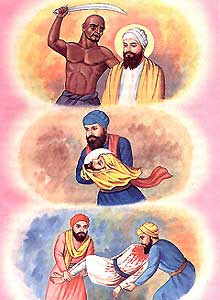The spreading of the fame of Guru Hargobind Sahib ji was not tolerated by Jahangir, and so ordered his soldiers to imprison him in the Gwalior Fort. As Guruji received the summon from Jahangir, he went to Delhi to have important discussions with Mata Ganga Ji, Baba Budha Ji, Bhai Gurdas Ji, Bhai Jetha Ji and Bhai Sahlo Ji. Then, after discussion he appeared before the Emperor Jahangir. A debate on Sikh religion and Sikh doctrines held between Guru Sahib and Jahangir, but emperor remained unimpressed and ordered for the imprisonment of Guru Sahib at Gwalior Fort. Guru Sahib was detained there from 1609 to 1612.
Sain Mian Mir and Wazir Khan, 'the Governor of Lahore' approached Jahangir to have the releasing orders of guru Hargobind Sahib ji. Guru ji kept a condition that he will come out only along with the fifty-two Hindu Princes, who were staying there at the Gwalior Fort as prisoners, and were released in 1612. Thus, ther title "Bandi Chhor Baba" was given to Guruji. Guru Sahib reached Amritsar on the occasion of Diwali. This was a big occasion for the Sikhs. It is said that Baba Budha Ji littered the earthen lamps throughout the Amritsar city.
From now, the attitude of Jahangir towards Guru Sahib changed considerably and remained friendly till the death of Jahangir. Shortly after having cordial relations with the state, Guru ji started to re-consolidate the Sikh Nation. Guru ji started spreading Sikhism by undertaking Dharam Parchar tours. Starting from Amritsar, he covered thousand miles in India. In Punjab he visited Kartarpur and made it as headquarter of Sikh Nation in Doaba, along with, visited several adjoining villages like Bara Pir, Mukerian and laid the foundation stone of Sri Hagobindpur town in 1621. This was a major achievement by Guru Hargobind Sahib ji. Now for the first time since the invasion of Muslims, with the guidance of Guru Hargobind Sahib Ji, sikh nation prepared for the armed resistance. This was to oppose the injustice of the Muslims, thus was an imperative measure of defense for the sikhs. Thus as army was prepared, ready to defend their interests with the swords.
Shah Jahan changed the policies after the death of emperor Jahangir. He ordered to destroy all the temples and Gurdwaras, which were under construction. The sacred Baoli of Guru Arjan Sahib in Dabbi Babar, Lahore was converted into a mosque, which was later re-excavated by Maharaja RanJit Singh but unfortunately was again destroyed in 1947, by the Muslims mobs. In 1629 Mukhlis Khan was made the Governor to Lahore. He and Qazi Rustam Khan were best friends. According to some historical accounts Kaulan(Mata), a Hindu lady, was forcibly abducted (kidnapped) by the Qazi Rustam Khan and was made a maid servant. Having been under the influence of Sain Mian Mir, she became a follower of Guru Sahib. On noticing her devotional interest in Sikh religion, the Qazi became harsh. With the help of Saint Mian Mir, she was safely escorted to Amritsar, Where she was provided with a safe and separate lodging. Within a short span, she won the sympathy of the Sikhs, and thus became popular among the Sikh masses. Later the pond near which she was living, was converted into a tank by Guru Sahib and was named Kaulsar, after the name of Kaulan Ji.
When Shah Jahan succeeded the throne after the death of his father Jahangir, Qazi Rustam Khan made a complaint to him for Guru sahib. Guru Sahib fought five battles, and won all. Soon after this, a tussle began over the two horses between Guru Sahib and Subedar of Lahore. These horses were forcibly snatched and taken into custody by the Mughal officials from the devotees of Guru Sahib. This incident was informed to Guru Sahib. Bhai Bidhi Chand a daring disciple recovered the horses one by one from the royal stable.
Guru Sahib crossed the Sutlej River and reached Kiratpur Sahib where he established another spiritual and preaching center of the Sikh Nation. Here, Guru Sahib spent ten years of his life and breathed his last on Chet Sudhi 5th (6th Chet Samvat 1701) 28th February 1644. It is said that when Guru's body was placed on fire, and as the flames rose high, a large number of Sikhs tried to burn themselves on the funeral pier. Before Guruji's death, Guru Sahib nominated Har Rai Sahib, as his successor, the second son of Baba Gurditta Ji.
Read more...




















